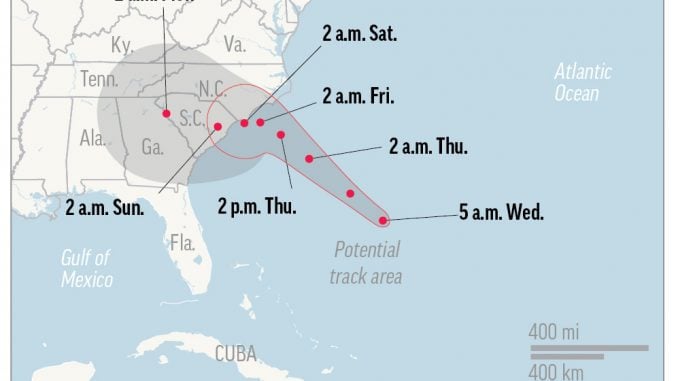
WILMINGTON — Motorists streamed inland on highways converted into one-way routes Tuesday as more than 1 million people in three states were ordered to get out of the way of Hurricane Florence, a hair-raising storm taking dead aim at the Carolinas with 130 mph winds and potentially ruinous rains.
Florence was expected to blow ashore late Thursday or early Friday, then slow down and wring itself out for days, unloading 1 to 2.5 feet of rain that could cause flooding well inland.
Forecasters and politicians pleaded with the public to take the warnings seriously and minced no words in describing the threat.
“This storm is a monster. It’s big and it’s vicious. It is an extremely, dangerous, life-threatening, historic hurricane,” North Carolina Gov. Roy Cooper said.
“The waves and the wind this storm may bring is nothing like you’ve ever seen,” he added. “Even if you’ve ridden out storms before, this one is different. Don’t bet your life on riding out a monster.”
North and South Carolina and Virginia ordered mass evacuations along the coast. But getting out of harm’s way could prove difficult.
Florence is so wide that a life-threatening storm surge was being pushed 300 miles ahead of its eye, and so rainy that a swath of states from South Carolina to Ohio and Pennsylvania could get deluged.
People across the region rushed to buy bottled water and other supplies, board up their homes or get out of town.
A line of heavy traffic moved away from the coast on Interstate 40, the main route between the port city of Wilmington and inland Raleigh, the few vehicles heading the other way only carried building supplies.
Between the two cities, about two hours apart, the traffic flowed smoothly in places and became gridlocked in others because of fender-benders.
Tuesday afternoon, the storm was southeast of Cape Fear, moving at 17 mph. It was a potentially catastrophic Category 4 storm but was expected to keep drawing energy from the warm water and intensify to near Category 5, which means winds of 157 mph or higher.
“This one really scares me,” National Hurricane Center Director Ken Graham said.
Forecasters said parts of North Carolina could get 20 inches of rain, if not more, with as much as 10 inches elsewhere in the state and in Virginia, parts of Maryland and Washington, D.C.
One trusted computer model, the European simulation, predicted more than 45 inches in parts of North Carolina. A year ago, people would have laughed off such a forecast, but the European model was accurate in predicting 60 inches of rain for Hurricane Harvey in the Houston area, so “you start to wonder what these models know that we don’t,” said University of Miami hurricane expert Brian McNoldy.
Rain measured in feet is “looking likely,” he said.
Florence could slam the Carolinas harder than any hurricane since Hazel, which was hit in 1954 with 130 mph winds. The Category 4 storm destroyed 15,000 buildings and killed 19 people in North Carolina. In the six decades since then, many thousands of people have moved to the coast. Florence’s projected path includes half a dozen nuclear power plants, pits holding coal ash and other industrial waste, and numerous hog farms that store animal waste in huge lagoons.
Duke Energy spokesman Ryan Mosier said operators would begin shutting down nuclear plants at least two hours before hurricane- force winds arrive.
Cooper has issued what he called a first-of-its-kind mandatory evacuation order for North Carolina’s fragile barrier islands from one end of the coast to the other. Typically, local governments in North Carolina make the call on evacuations. Some, including those at the Outer Banks, had already issued orders for the island residents to leave.
“We’ve seen nor’easters and we’ve seen hurricanes before,” Cooper said, “but this one is different.”
However, some residents have decided to ignore the mandatory evacuation order. Liz Browning Fox in the village of Buxton is one of them. The 65-year-old Fox says her 88-year-old mother has refused to evacuate her house next door so she’s going to stay with her.
She says her brother who lives nearby is also going to stay. Fox says she feels safe in her home but realizes that if she and her mother get in trouble during the storm, no first responders are going to arrive to help them. She says anyone who plans to stay “needs to be pretty well set up.”
Despite her resolve to stay, Fox admits she woke up in the predawn hours asking herself why she had decided to stay. She says what she most fears are the tornadoes that often develop along with hurricanes. Those, she says, “can tear through anything.”
The longtime resident is a volunteer for the community radio station, Radio Hatteras. She says she will help broadcast emergency messages during the storm.



